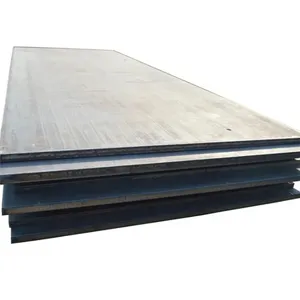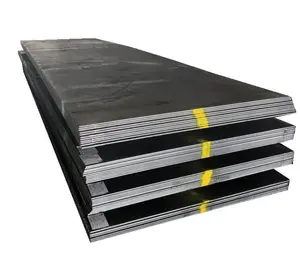
Q235B Ss400 S235jr ASTM A36 St37-2 Q345b S355jr Hot Rolled Steel Plate Flat Iron Cold Rolled Carbon Steel Sheet


Cold Rolled Sj235jr Ss440 1020 1050 1045 Black Iron Steel Ss400 Flat Metal Sheet Astm A36 Q235 Mild Carbon Steel Plate














The construction industry is undergoing a revolution, with flat metal sheets at the forefront. These thin, flat pieces of metal, formed by industrial processes, are versatile and find extensive use in various sectors. From the manufacturing of cars, aircraft, and house appliances to construction applications like ducts and gutters, flat metal sheets are ubiquitous. This article delves into the understanding of flat metal sheets, their types and properties, and their pivotal role in construction. It further explores the innovative uses of these sheets in sustainable building design, energy efficiency, modular construction, and the integration of IoT in smart buildings.
Flat metal sheets, or sheet metal, are thin, flat pieces of metal formed by industrial processes. They can range from extremely thin sheets, considered foil or leaf, to up to 6 mm (0.25 in) sheets. Sheet metal is widely used in various industries, including the manufacturing of cars, aircraft, trains, hardware enclosures, office tools, furniture, house appliances, computers, machine components, and beverage cans. It's also used in construction for ducts and gutters. Many different metals can be processed into sheet metal, including aluminum, steel, brass, tin, copper, nickel, titanium, and even precious metals like gold, silver, and platinum.
Flat metal sheets come in various types, each with unique properties, making them versatile for different applications. Steel, a widely-used metal for sheet work, has many alloys, each developed for their individual strengths. Austenitic steel, a subset, is non-magnetic, highly formable, and corrosion-resistant. Aluminium offers an incredible strength to weight ratio, providing a strong, light, and easy-to-install material. It's often found in electric overheads and transmission cables. Brass, known for its aesthetic appeal, is malleable and forms a protective oxide layer that prevents further erosion.
Aluminium sheets, due to their unique properties, find applications in various sectors such as automotive, building, and HVAC-R. These products can undergo specific surface treatments to meet diverse customer requirements. Additionally, prepainted aluminium sheets are available, enhancing their versatility.
Steel sheets are a versatile construction material, deriving their mechanical properties from their chemical composition and manufacturing processes. The strength of steel sheets can be increased by the addition of alloys such as manganese, niobium, and vanadium. However, these alloy additions can also affect other properties, such as ductility, toughness, and weldability. The properties of steel sheets are retained unless reheated above 650°C. The process for Quenched and Tempered steel starts with a normalized material at 900°C, producing steel with high strength and hardness, but low toughness. The toughness is restored by reheating it to 600°C, maintaining the temperature for a specific time, and then allowing it to cool naturally.
Copper sheets are high-quality pure copper sheets used in various applications. They are ideal for construction, crafts, art projects, embossing, manufacturing, and electrical applications, including RF shielding. They are smooth, annealed, and very malleable, adhering to high-quality specifications. These sheets, often referred to as 'roofing copper,' are preferred for many roofing and flashing projects due to their durability and the ability to be bent and formed by hand.
Flat metal sheets, specifically flat-rolled steel, play a crucial role in the construction industry. They are fundamental to building structures like communities, hospitals, schools, bridges, and roads. Moreover, they are vital in manufacturing heavy equipment needed for construction activities. Flat-rolled steel sheets offer strength, flexibility, and sustainability, making them suitable for high-rise towers, big stores, industrial facilities, and airports. They also withstand the harsh conditions of construction sites, including dust, debris, and exposure to chemicals and moisture.
Sheet metal, a common type of flat metal sheet, is extensively used in construction projects. It plays a crucial role in holding architectural and structural components together, ensuring they maintain their shape. Sheet metal cladding, another application, is used to cover large areas such as rooftops or partitions. Additionally, sheet metal is often combined with other materials to construct walls, floors, and ceilings, demonstrating its versatility and importance in structural applications.
Ornamental sheet metal, a type of flat metal sheet, plays a significant role in architectural applications. It's used to invoke a timeless, intriguing look, add creativity, evoke elegance, or restore historical prestige. It also provides functional purposes such as sound absorption, reflection, and drainage. Different types of sheet metal can achieve varying visual effects and provide enhanced advantages. For instance, decorative sheet metal can be designed and employed in a variety of ways — intriguing details, eloquent accents, breathtaking panels, or intricate fixtures. It's not only aesthetically pleasing but also provides incredible functionality.
Metal, including flat metal sheets, has innovative uses in sustainable building design. These sheets can be used to create wall panels, roofing products, and solar shading screens. They also play a role in pipe insulation and radiant floor systems to reduce energy loss. Flat metal sheets are light but strong, making them ideal for structural components. Their use in sustainable building design not only conserves resources but also ensures the longevity of the structure.
Flat metal sheets, particularly insulated metal panels, offer significant energy efficiency and sustainability benefits. The insulated foam core of these panels enhances their energy-efficient performance, controlling airflow and maintaining indoor climate. High-end insulated metal panels can have thermal ratings between 5 and 7.1 per square inch, significantly higher than traditional building materials like wood. Additionally, these panels are eco-friendly and low maintenance, contributing to their sustainability. The time and money saved during construction, coupled with potential utility cost savings, make these panels a cost-effective and sustainable choice.
Modular buildings often employ sheet metal cladding with a ribbed profile due to its high mechanical strength, weather resistance, and ease of installation. These metal sheets, delivered as prefabricated panels, allow for quick assembly, reducing construction time and costs. The material's resistance to external factors like rain, snow, wind, and UV radiation ensures durability and low maintenance. Furthermore, the versatility of flat metal sheets allows for diverse facade designs, making them an excellent choice for modular and prefabricated construction.
The Internet of Things (IoT) is revolutionizing the construction industry, including the use of flat metal sheets in smart buildings. IoT devices, connected via the internet, collect and share data to create efficiencies. These devices can be integrated into building materials, such as flat metal sheets, to monitor structural integrity, energy efficiency, and more. For instance, sensors in metal sheets could relay data about stresses or faults, enabling timely repairs. The IoT's potential in construction is vast, from improving safety to optimizing resource use, and flat metal sheets play a crucial role in this technological integration.
Flat metal sheets have proven to be a game-changer in the construction industry. Their versatility, strength, and adaptability to various applications make them an indispensable material. From structural to architectural applications, these sheets have revolutionized the way we build and design. Their innovative uses in sustainable building design, energy efficiency, and modular construction have not only conserved resources but also ensured the longevity of structures. Furthermore, the integration of IoT in flat metal sheets is paving the way for smart buildings, optimizing resource use, and improving safety. In essence, flat metal sheets are not just shaping our buildings but also the future of the construction industry.